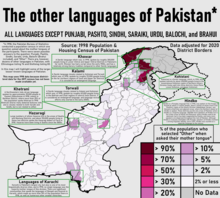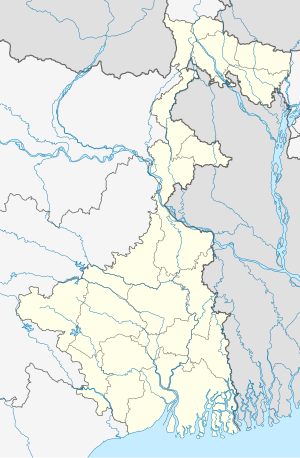토르왈리어
Torwali language| 토르왈리 | |
|---|---|
| ت ★★★★ | |
 | |
| 지역 | 스와트 구 |
| 민족성 | 토르왈리족 |
원어민 스피커 | 110,000[1][2](2001)[3] |
| 아랍어 문자(주로 나스타리크) | |
| 언어 코드 | |
| ISO 639-3 | trw |
| 글로톨로그 | torw1241 |
| ELP | 토르왈리 |
 토왈리는 중앙 스와트 지역에서 주로 사용되는 파키스탄의 소수 언어이며, 이 지도에는 공백이 있습니다. | |

토르왈리어(تTorwali)는 [4][5]파키스탄 스와트 지역의 바레인 및 차일 지역에서 주로 사용되는 인도아리아어족 언어이다.언어와 파슈툰이 아닌 다른 공동체들은 종종 "코히스타니"라고 언급되는데, 이것은 스와트 파슈툰족에 의해 붙여진 이름이다.Fredrik Barth는 "파탄인들은 그들을 부르고 힌두쿠시 계곡의 다른 모든 인도계 무함마드인들은 코히스타니스라고 부른다"[6][7]고 말한다.토르왈리어는 [8][9]스왓의 이슬람 이전 공동체에서 유래되었다고 한다.그것은 오늘날까지 사용되고 있는 현대 인도-아리아 언어 중 가장 가까운 언어이며, [10][11]간다라의 고대 지역에서 사용되었던 중세 인도-아리아 언어인 간다르어의 방언인 니야와 유사하다.
토르왈리는 멸종위기 언어이다: 유네스코의 멸종위기 언어 지도책에서 "확실히 멸종위기 언어"[12][13]로, 그리고 멸종위기 언어 카탈로그에서 "취약"으로 특징지어진다.2004년부터 이 언어를 활성화하기 위한 노력이 있었고, Idara Baraye Talem-o-Taraqi(IBT)[14]에 의해 모국어 커뮤니티 학교가 설립되었습니다.
음운론
비록 토왈리 음운론에 대한 설명이 문헌에 등장했지만, 몇몇 의문점들은 여전히 [15][16]풀리지 않고 있다.
모음.
| 전선. | 중앙의 | 뒤로 | |
|---|---|---|---|
| 가까운. | 저는... | uuuuuuuuuuuuuu개요 | |
| 중앙의 | excounts(e440) | 오오오 | |
| 열다. | 여자 아이 |
Grierson과 Morgenstierne에 기초한 Edelman의 분석은 적어도 /e [15]o a/에 대한 비음 대응물을 보여주며, 또한 다음과 같이 번역된 일련의 중심(축소?) 모음을 발견했다.
| 전선. | 중앙의 | 뒤로 | |
|---|---|---|---|
| 가까운. | i ĩ | ( ̙ ( ) | u u |
| 중앙의 | e ( e ) | ( ( ̙ ) | o õ |
| 열다. | æ æ | a |
Lunsford는 모음 음소를 결정하는데 어려움을 겪었으며 / distrib/([i]]일 수도 있음), /e//, /̙/,[16] /̙/와 같이 제한된 분포로 철회된 모음이 있을 수 있다고 제안했다.Kalash-mondr에서도 [17]후퇴모음 또는 역굴절모음이 발견된다.
자음
호흡 유성 계열의 음소 상태는 논란의 여지가 있다.
상태가 특히 불확실한 사운드는 물음표로 표시됩니다.
| 순음부 | 코로나 | 레트로플렉스 | 수술 후/ 구개음 | 벨라 | 성문 | |||||||
|---|---|---|---|---|---|---|---|---|---|---|---|---|
| 비음 | m | n | (표준) | ŋ | ||||||||
| 이제 그만 | p p440 | b 밧테루 | t 동작하다 | d d440 | ʈ ʈʰ | ɖ ɖʱ | k 키 | g ɡʱ | ||||
| 파찰하다 | ts | ʈʂ ʈʂʰ | ɖʐ | 동작하다 하지 않다 | d440 | |||||||
| 마찰음 (가로) | s | z | ʂ | ʐ | ʃ | ʒ | x | ɣ | h | |||
| (t) 표시? | ||||||||||||
| 대략적인 (가로) | j | w | ||||||||||
| l | ||||||||||||
| 로틱 | r | ɽ? | ||||||||||
레퍼런스
- ^ Khan, Amber. "Timeline of Torwali Speaker Estimates". torwali.omeka.net. Amber Khan for Southern Illinois University Edwardsville. Retrieved 31 March 2019.
- ^ Torwali, Zubair (2014). "Vestiges of Torwali culture". doi:10.13140/RG.2.1.2272.1049. Archived from the original on 7 November 2017.
{{cite journal}}:Cite 저널 요구 사항journal=(도움말)[자체 인식 소스?] - ^ Torwali at Etnologue (2015년 제18호) (구독 필요)
- ^ Kreutzmann, Hermann (2005). "Linguistic diversity in space and time: A survey in the Eastern Hindukush and Karakoram". Himalayan Linguistics. Center for Development Studies, Free University of Berlin. 4: 7.
- ^ Torwali, Zubair (2016). "Reversing Language Loss through an Identity Based Educational Planning: The Case of Torwali language" (PDF). Eurasian Journal of Humanities. 1 (2): 24.
- ^ Biddulph, John (1880). Tribes of the Hindoo Koosh (PDF). Graz, Austria: 1971 edition Akadmeische Druck u Verlagasasntalt. p. 69.
- ^ Barth, Fredrik (1956). Indus and Swat Kohistan: an Ethnographic Survey. Oslo. p. 52. 파탄족은 그들을 힌두쿠시 계곡의 다른 모든 인도계 무함마드인 코히스타니스라고 부른다.
- ^ Torwali, Zubair. "Revitalization of Torwali poetry and music". We Mountains – Regional Website of North Pakistan. IBT. Retrieved 5 March 2019.
- ^ Inam-ur-Rahim; Viaro, lain M. (2002). Swat: An Afghan Society in Pakistan. Karachi and Geneva: City Press and Graduate Institute of Developmental Studies. ISBN 9698380558. OCLC 603642121.
- ^ Burrow, T. (1936). "The Dialectical Position of the Niya Prakrit". Bulletin of the School of Oriental Studies, University of London. 8 (2/3): 419–435. ISSN 1356-1898. JSTOR 608051.
... It might be going too far to say that Torwali is the direct lineal descendant of the Niya Prakrit, but there is no doubt that out of all the modern languages it shows the closest resemblance to it. A glance at the map in the Linguistic Survey of India shows that the area at present covered by "Kohistani" is the nearest to that area round Peshawar, where, as stated above, there is most reason to believe was the original home of the Niya Prakrit. That conclusion, which was reached for other reasons, is thus confirmed by the distribution of the modern dialects.
- ^ Salomon, Richard (1998-12-10). Indian Epigraphy: A Guide to the Study of Inscriptions in Sanskrit, Prakrit, and the other Indo-Aryan Languages. Oxford University Press. p. 79. ISBN 978-0-19-535666-3.
- ^ Torwali, Zubair (2016). "Reversing Language Loss through an Identity Based Educational Planning: The Case of Torwali language" (PDF). Eurasian Journal of Humanities. 1 (2): 24.
- ^ Hammarström, Harald. "Torwali". Glottolog. Retrieved 17 April 2019.
- ^ Liljegren, Henrik (2018). "Supporting and Sustaining Language Vitality in Northern Pakistan". The Routledge Handbook of Language Revitalization. pp. 427–437. doi:10.4324/9781315561271-54. ISBN 978-1-315-56127-1.
- ^ a b c Èdel'man, Džoj Iosifovna (1983). The Dardic and Nuristani languages. Nauka. OCLC 1014554012.[페이지 필요]
- ^ a b c Lunsford, Wayne A. (2001). An overview of linguistic structures in Torwali, a language of Northern Pakistan (PDF) (Thesis). pp. 26–30. OCLC 48846858.
- ^ Kochetov, Alexei; Arsenault, Paul (2008), Retroflex harmony in Kalasha: Agreement or spreading? (PDF), NELS, vol. 39, Cornell University, p. 4
참고 문헌
- 비둘프, 존(1880).'힌두쿠시 족'
- Grierson, George Abraham (1929). Torwali: An Account of a Dardic Language of the Swat Kohistan. Asian Educational Services. ISBN 978-81-206-1605-9.
- 울라, 이남(2004년).5월 24일부터 26일까지 태국 치앙마이에서 열린 아시아 사전 편집 회의에서 발표된 논문 "토왈리 사전의 사전 데이터베이스".
- 멸종위기언어프로젝트;http://www.endangeredlanguages.com/lang/3501/guide
- 사운드 클라우드 https://soundcloud.com/zubairtorwali/sets/manjoora-torwali-melodies
- 의회도서관 https://books.google.com/books?id=JHLalS4Jp1oC&pg=PA7522&lpg=PA7522&dq=Torwali&source=bl&ots=NmYGuAzW7a&sig=ACfU3U1CDV7cwH6W1JF2R6GYYgQ_wkkUqw&hl=en&sa=X&ved=2ahUKEwjcq9qB-u3gAhWx_XMBHWngC244WhDoATABegQIAxAB#v=onepage&q=Torwali&f=false
- 잘랄 우딘 https://paperswithcode.com/paper/a-step-towards-torwali-machine-translation-an
- Torwali, Zubair (2015). Muffled voices: longing for a pluralist & peaceful Pakistan. ISBN 978-969-8985-06-6.
- Ahmad, Aftab (2015) Torvarl ur Urdu, angrez lug lugh̲at = Torwali-Urdu-영어사전 https://trove.nla.gov.au/version/243822077
외부 링크
- https://dsal.uchicago.edu/dictionaries/torwali/ 오디오 포함 디지털 Torwali 영어사전
- https://182.180.102.251:8081/otd/HomePage.aspx/온라인 Torwali-Urdu 사전(파키스탄 UET 언어공학센터)
- https://www.unesco.org/culture/ich/doc/src/00851-EN.doc (유엔스코 언어보존 모범사례 등록부)
- 잘랄 우딘 https://www.aclweb.org/anthology/W19-6802
- http://torwaliresearchforums.org/ Torwali 언어 및 Torwali 언어로 이루어진 컴퓨터 개발에 대한 정보를 제공하는 웹사이트.잘랄루딘
- https://web.archive.org/web/20151208134056/http://torwali.base.pk/ 토르왈리어와 토르왈리족의 역사에 대한 정보를 제공하는 웹사이트.사진, 분류 등이 포함됩니다.
- https://www.torwali.org는 스와트 기반의 단체 Idara Baraye Taleem-o-Taraqi(IBT)가 관리하는 웹사이트로 토르왈리족을 포함한 파키스탄 민족주의 커뮤니티의 통합 발전을 위해 활동하고 있습니다.
- https://torwali.omeka.net/ Southern Illinois University Edwardsville 영어 318을 위해 Amber Khan이 만든 멸종위기 언어 프로젝트
- Ahmad, Aftab (2016) 정체성 기반 교육 계획을 통해 언어 손실을 되돌리는 - Torwali 언어의 경우.http://www.lc.mahidol.ac.th/mleconf/2016/Documents/PresentedFiles/Parallel%20VI/T3-9/5C-Aftab%20Ahmad.pdf


